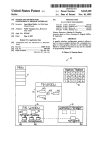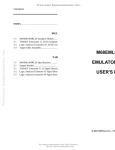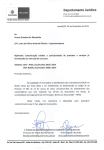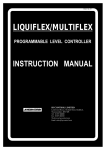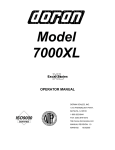Download User Manual - Barcode Datalink
Transcript
Waterproof Digital Platform Scale HV-60KGL-WP HV-200KGL-WP ADM-HVG-WP HV-60KGV-WP HV-200KGV-WP This is a hazard alert mark. This mark informs you about the operation of the product. Note This manual is subject to change without notice at any time to improve the product. No part of this manual may be photocopied, reproduced, or translated into another language without the prior written consent of the A&D Company. Product specifications are subject to change without any obligation on the part of the manufacture. Contents 1. Compliance ................................................................................................ 3 1.1.1. Compliance with FCC rules ........................................................... 3 1.1.2. Classification of protection provided by enclosures........................................ 3 2. Outline and Features ................................................................................. 4 3. Unpacking .................................................................................................. 5 3.1. Accessories and Options list.............................................................. 6 4. Caution ...................................................................................................... 7 4.1. Precautions for Installing the Scale.................................................... 7 4.2. Precautions for Operating the Scale .................................................. 7 4.3. Precautions for Storing the Scale ...................................................... 7 5. Installing the Scale..................................................................................... 8 5.1. Removing the column ........................................................................ 9 6. Names ..................................................................................................... 10 6.1. Display and Symbols ....................................................................... 12 6.2. Keys................................................................................................. 14 7. Basic Operation ....................................................................................... 16 7.1. Turning the Scale on/off and Weighing ............................................ 16 7.1.1. Type V or Type L with AC Adapter .............................................. 16 7.1.2. Type L with Rechargeable batteries ............................................ 17 Tare (And Net Display)................................................................................. 18 7.1.3. Manual Tare ................................................................................ 18 7.1.4. Preset Tare.................................................................................. 18 7.2. Weighing Range for the HVG-WP series ......................................... 19 7.3. Mode Key (Changing Unit and Mode).............................................. 20 8. Counting Mode......................................................................................... 22 8.1. Storing a Unit Mass ......................................................................... 22 8.2. Counting the number of articles ....................................................... 23 9. Percentage Mode..................................................................................... 24 9.1. Storing a 100% Mass....................................................................... 24 9.2. Reading percentage ........................................................................ 25 10. Accumulation Function ........................................................................ 26 10.1. Preparation (Setting Parameters) .................................................... 27 . 27 10.2. Operation and Performance (Examples).......................................... 28 11. Upper/Lower Comparator Function ................................................................. 29 11.1. Preparation (Setting Parameters) .................................................... 30 11.2. Operation and Performance (Examples).......................................... 32 12. Full/Dribble Batch Function ...................................................................... 33 12.1. Preparation (Setting Parameters) .................................................... 35 13. Simple Batch Function......................................................................... 37 13.1. Preparation (Setting Parameters) .................................................... 38 13.2. Operation and Performance (Examples).......................................... 39 14. Calibration (Adjusting the Scale).......................................................... 40 14.1.1. The Gravity Acceleration Table ................................................. 41 14.2. The Complete Calibration Procedure............................................... 42 14.2.1. Gravity Acceleration Correction................................................. 42 14.2.2. Preparation................................................................................ 42 14.2.3. Calibration of the Zero Point...................................................... 43 14.2.4. Span Calibration........................................................................ 43 15. The Function Table.............................................................................. 44 15.1. The Procedure for Setting Parameters ............................................ 44 15.2. Parameter List ................................................................................. 45 16. RS-232C Serial Interface..................................................................... 48 16.1. Data Format..................................................................................... 49 16.2. Stream Mode ................................................................................... 51 16.2.1. Preparation and Performance (Examples) ................................ 51 16.3. Command mode .............................................................................. 52 16.3.1. Command List ........................................................................... 52 16.3.2. Example of Setting Parameters................................................. 55 17. Options ................................................................................................ 56 17.1. Extension cable (OP-02).................................................................. 56 17.2. RS-232C/ Relay output/ Buzzer (OP-03) ......................................... 57 17.2.1. Installing the OP-03 ................................................................... 58 17.3. RS-422/ RS-485 / Relay output (OP-04).......................................... 59 17.3.1. Installing the OP-04 ................................................................... 60 17.3.2. Communication Format ............................................................. 61 17.4. Roller Conveyor (OP-13, OP-14) ..................................................... 64 18. Specification ........................................................................................ 65 19. Maintenance ........................................................................................ 67 19.1.1. Repair........................................................................................ 67 19.2. Check points Before Calling Maintenance Service ..................................... 67 Page 2 HVG-WP Series 1. Compliance 1.1.1. Compliance with FCC rules Please note that this equipment generates uses and can radiate radio frequency energy. This equipment has been tested and has been found to comply with the limits of a Class A computing device pursuant to Subpart J of Part 15 of FCC rules. These rules are designed to provide reasonable protection against interference when this equipment is operated in a commercial environment. If this unit is operated in a residential area it may cause some interference and under these circumstances the user would be required to take, at his own expense, whatever measures are necessary to eliminate the interference. (FCC = Federal Communications Commission in the U.S.A.) 1.1.2. Classification of protection provided by enclosures This equipment is designed to comply with the IP Code of IEC 529. The "IP-65" code is explained as follows: "IP" International Protection. "6" Against ingress of solid foreign objects. Dust-tight. No ingress of dust. "5" Against ingress of water with harmful effects. Protected against water jets (no powerful jets). Water projected in jets against the enclosure from any direction shall have no harmful effects. Compliance with European Directive This appliance features radio interference suppression and safety of electrical equipment designed for certain voltage in compliance with valid EC Regulation 89/366/EEC and 73/23/EEC. Note: The displayed value may be adversely affected under extreme electromagnetic influences. HVG-WP Series Page 3 2. Outline and Features These scales are designed to comply with IP-65 of IEC 529 The HVG-WP series is a platform scale with 1/3000 resolution, and has a "triple weighing range" function to select the weighing range. Type L scales have an LCD (Liquid Crystal Display) and use rechargeable batteries as power source to enable use without connecting to AC power. This type can also use an AC adaptor. Type V scales have a fluorescent display so the display can be read in dim light. This type uses an AC power line as a power source. The counting mode function calculates individual unit weight from a sample of the items to be counted. Once this unit weight is entered, bulk quantities can be counted and shown as a pcs display. The scales can display the unit of percentage. The accumulation function accumulates each weighing value and can display totals for weight and number of items. The comparator function compares the display value with the upper limit value (HI), lower limit value (LO) and displays the result. The result can be output if option OP-03 is installed. The simple batch function or full/dribble batch function can be used for batching to a target mass value. The status of a weighing value can be output if option OP-03 or OP-04 is installed. The outputs are zero band, preliminary and Final. Using the optional RS-422/RS-485 serial interface and a computer, up to 16 scales can be controlled, if this option is installed in place of the RS-232C serial interface. The following parameters are stored in the product with no power supplied. Unit mass of the counting mode 100% mass of the percentage mode Total counts and total mass of the accumulation function Upper limit value and lower limit value of the upper / lower comparator function, Final value, preliminary value and zero band of the full / dribble batch function or Final value, preliminary value and zero band of the simple batch function Calibration data Parameters of the function table (f1 ~ f16) Page 4 HVG-WP Series 3. Unpacking Products Products HV-60KGL-WP HV-60KGV-WP HV-60KGV-WP HW-60KGV-WP HV-200KGV-WP HV-60KGL-WP HV-200KGL-WP HW-60KGL-WP Display Unit All Accessories Refer to the accessories list at next page. The combination of accessories is according to the product. TB:300 AC Adapter ! Please confirm that AC adapter type is correct for your local voltage and receptacle type. Base Unit Caution Do not pull the load cell cable 6mm allen wrench ? Instruction Manual Please conform that the Main power type or AC adapter type is correct for your local voltage and receptacle type. ? Do not remove the rechargeable batteries from the indicator (type L). HVG-WP Series Page 5 3.1. Accessories and Options list Accessories for the HVG-WP series Products Type V Type L Accessories 6mm Allen wrench Instruction manual Warranty card HV-60KGV-WP HV-200KGV-WP TB: 300 AC adapter 6mm Allen wrench Instruction manual Warranty card HV-60KGL-WP HV-200KGL-WP Options List OP-02 OP-03 OP-04 OP-13 OP-14 Order code or option name Accessories 5m extension loadcell cable Tapping screw M4x10 RS-232C interface/ Relay output/ Buzzer Connector JA:TCP0586 Connector TM:BLA9 RS-422/485 interface with relay output AC adapter Roller conveyor for HV-200KGV-WP Roller conveyor for HV-60KGV-WP Page 6 HVG-WP Series 4. Caution 4.1. Precautions for Installing the Scale Ground the scale, so that the user will not be subjected to an electric shock. Do not handle the Main power cord with wet hands. The AC plug is not water-resistant. Install it in an area where it does not get wet. Do not install the scale where there is flammable or corrosive gas present. Do not install the scale under water. Do not pull, fold or arrange cables forcibly. Consider the following conditions to get the most from your scale. The best operation is where the temperature and relative humidity are stable, the place to install the scale is a solid floor, there is no draft and the power source is stable. Do not install the scale in direct sunlight. Do not install the scale near heaters or air conditioners. Do not install the scale near equipment which produces magnetic fields. Do not install the scale in a place where it is apt to be charged with static electricity, or where the relative humidity is lower than 45%RH. Plastic and isolators are apt to be charged with static electricity. Do not use an unstable power source. 4.2. Precautions for Operating the Scale Periodically ensure that the weighing value is correct. Calibrate the scale before using and after moving it to another location. Do not place anything on the weighing pan which is heavier than the weighing capacity Do not drop anything upon the weighing pan. Do not use a sharp instrument such as a pencil or ball-point pen to press the keys. Press the keys gently using only your finger. We recommend pressing the ZERO or TARE key before each weighing to prevent possible error. 4.3. Precautions for Storing the Scale Do not disassemble the scale. Do not use solvents to clean the scale. For best cleaning of the display unit, wipe with a dry lint free cloth or a lint free cloth which is moistened with warm water and a mild detergent. The base unit can be cleaned with gentle water jets while brushing the base unit. Weigh only after the unit is dry. Do not use a powerful water jet. Do not remove rechargeble batteries from display unit. HVG-WP Series Page 7 5. Installing the Scale This procedure includes all of the steps for installing the HV-WP series and HW-WP series. Therefore, on some products, there are some unnecessary steps. Step 1 Connect the indicator unit to the column with the accesory knobs and rubber washers. Column Cable Indicator Step 2 Take the base unit and column out, taking care that the load-cell cable is not pulled. Knob Rubber washer Pan Column Step 3 Put the weighing pan on the base unit. Step 3 Step 4 Insert the remainder of the load cell cable into the column. Attach the column to the bracket of the base unit so as not to damage the load cell cable. Affix the column to the bracket using two 6mm Allen screws. Step 2 Load-cell cable Base unit Bubble spirit level Step 5 Select the place for installing the scale. Also consider "4. Caution" on page 7. Leveling foot Step 5 Step 6 Adjust the level of the base unit by using the "Bubble spirit level" and "Leveling foot". OK Power label NG Earth Step 7 Ground the scale using the earth terminal. Step6 Earth terminal Caution Please confirm that the local voltage and the receptacle type are correct for your scale. Power terminals Earth Step7 Step 8 Adjust the angle of the indicator unit using the knobs on the side of indicator unit. Knob Step 9 Check the weighing accuracy. If the scale needs calibration, refer to "14. Calibration". on page 40. Page 8 HVG-WP Series 5.1. Removing the column Caution Remove the main power plug before removing the column (type V) Remove the AC adapter before removing the column (Type L) When removing the loadcell cable, do not pull the loadcell cable connector forcibly and do not pull on the wires of the cable. Do not bend the cable forcibly. Avoid dust, static electricity and high humidity (or drops) because the inside of the indicator unit is very sensitive. Procedure Step 1 Remove the power plug from the power outlet. (Type V). Remove AC adapter from the Power Jack (Type L). Step 2 Open the rear cover of indicator unit. Disconnect the loadcell cable connector gently (perpendicularly, do not pull to the side). Connector Screw and O ring Step 3 Remove the ferrite core and cable clamp from the loadcell cable. Step 4 Loosen the knobs to remove the indicator unit. Ferrite core Wind up 2 times Step 5 Remove four 6mm screws from the bottom of the column. Step 6 Carefully remove the cable from the pole and pole base so that the connector is not pulled forcibly. Step 7 Arrange the cable so that it does not touch the weighing pan in the base unit. The untied cable is at least 2m long. The optional extension loadcell cable (OP-02) is 5m long. HVG-WP Series Page 9 Cable clamp Loadcell cable knob Pole Step 8 Removing the column from the base unit, Connector Screw and O ring Step 9 Wind the cable through the ferrite core two times. Affix the cable to the rear cover using the cable clamp. Step 10 Connect the cable to the connnector. Close the rear cover. Ferrite core Wind up 2 times Cable clamp Loadcell cable Step 11 Confirm the accuracy of the scale. 6. Names Display Unit Knob for angle adjstment Pole Pan (Weighing Pan) Base Unit Leveling Foot Page 10 HVG-WP Series D is p la y Weighing condition Weighing data Bubble spirit level Units STABLE NET ZERO PT READY M+ 5kg 6kg 3kg HI OK LO Indicator of function Leveling foot CAP. Max 15/30/60kg d=5/10/20g Keys OK NG Rear of Indicator Unit (VFD) Knob for angle adjustment Calibration sealing panel Earth terminal Inside of rear panel RS-232C DIN connector Cable clamp for load cell cable Cable clamp for option Load cell cable Main power cord Earth terminal Power line terminal Please Confirm that the local voltage and receptacle type are correct for your scale. Rear of Indicator Unit (LCD) Knob for angle adjustment Calibration sealing panel Earth terminal Inside of rear panel RS-232C DIN connector Rechargeable batteries pack Cable clamp for adapter Load cell cable Cable clamp for option HVG-WP Series Page 11 Please Confirm that the local voltage and receptacle type are correct for your scale. 6.1. Display and Symbols Display and Symbols Meaning Stability indicator. Indicates the stability status of the weight display. Symbol is lit when the display is stable. Zero indicator. Indicates true center of zero of the weight indication. Net indicator. Indicates a tare value has been entered and that the weight displayed is a net value. Preset tare indicator. Indicates a preset tare has been entered. Accumulation indicator. Indicates the accumulation function is in use. Ready indicator. Used with the full/dribble feed batching function. ON Weight within zero band and ready to batch. OFF weight is outside the zero band. Blinking The start or end of the full/dribble batch process above the zero-band. The comparator indicator. Using the comparator function and comparing a weighing value with the upper and lower limits, the result is indicated. Using the full/dribble batch function, the full flow gate indicator is OK, the dribble flow gate indicator is HI and the zero band indicator is LO. 60 60 30 Weighed mass value 15 The weighing range indicator for the HV-WP series. The current range is indicated. Example. Display of zero (zero point). With nothing on the weighing pan and pressing the ZERO key, this mark is displayed. The zero point mark is displayed. The stability mark is displayed. Example. Display of the counting mode. This mode uses the registered unit mass, and counts the amount of articles on the weighing pan. The unit is . Page 12 HVG-WP Series A A A A A A A A A A A A A A A A A A A A A A A A A A A A A A A A A A A A A A A A Display and Symbols Meaning Example. Storing the unit mass of the counting mode. This is a display of zero point for the counting mode and uses 20 pieces for the registration. Example. Storing the unit mass of the counting mode. The sign "-" means "weighing value is not zero". Sample number is 10 pieces. Example. Percentage mode. This mode uses the registered 100% mass, and converts the weighing value to a percentage. The unit is % . Example. Display of the function table. This function table sets parameters of items. < key Selecting an item. ∧ key Selecting the parameter of an item. ENTER key Storing new parameters. Example. Preset tare. Entering tare with digital input. < key Selecting a figure. ∧ key Selecting a number. ENTER key Storing a new tare. Fixed value Example. Hold display The hold display is set using f12 of the function table. When the value is "nearly-zero" or changes more than 25% +30 digits, the hold is canceled. Over load display. Remove the mass from the weighing pan. Weighing error. Check the base unit and weighing pan. Calibration error. The calibration mass is too light. Check the base unit and weighing pan. Calibration error. The calibration mass is too heavy. Check the base unit and weighing pan. The " nearly-zero " is within ±4 digits from zero point in the unit of kg. HVG-WP Series Page 13 6.1. Display and Symbols A A A A A A A A A A A A A A A A A A A A A A A A A A A A A A A A A A A A A A A A A A Display and Symbols Meaning An error where the weighing value is unstable due to drift, vibration or other, when turning on the scale. Check around the weighing pan. Check the connection of load cell cable. Remove anything that may be on the weighing pan. Check around weighing pan. Perform zero point calibration of the scale. Error indication. Refer to "19 Maintenance". Accumulated data count. Total mass value of the accumulated data. Comparator function, display is an upper limit. Full/dribble batch function, the display is a final value. Full/dribble batch function, the display is a preliminary value. Comparator function, display is a lower limit. Full/dribble batch function, the display is the zero band. CAP. MAX. 15/30/60kg d=5/10/20g Description of the weighing unit, weighing range and measurable minimum mass. A A A A A A A A A A A A A A A A A A A A A A A 6.2. Keys Display and Symbols Meaning Display ON/ OFF key. Note Standby status when power is connected. Zero key. When there is nothing on the weighing pan and the ZERO key is pressed, the scale displays the mass value of zero and the zero point mark. Net is canceled, if it is displayed. Tare key. Canceling the mass of a receptacle, case, bag, etc. which is put on the weighing pan, and does not weigh its mass. Range key, Sample key. Changing weighing range for HVG-WP series.(Refer to f2 ) Storing the unit mass, it is used to select a sample number. In the function table, it is used to select a parameter. Page 14 HVG-WP Series A A A A A A A A A A A A A A A Display and Symbols Meaning Set key. Turns the comparator on/off. (Refer to f6 ) Counting mode, it is used to enter the mode to store the unit mass. Percentage mode, it is used to enter the mode to store the 100% mass. The full/dribble batch function, it is used as a start key. For the preset tare and selecting a calibration mass, it is used to select a figure. Mode key. Changing the current unit. While setting modes, this key is used for " storing a parameter and proceeding to the next step". F key. Full/dribble batch function, it is used to finish the process. (Refer to f10 ) Hold key. (Refer to f12 ) Setting a preset tare, selects polarity (+,-). Used to enter the function table. Used to enter the mode to set a preset tare. HVG-WP Series Page 15 A A A A A A A A A A A A A A A A A A A A A A A A A A A A A 7. Basic Operation 7.1. Turning the Scale on/off and Weighing 7.1.1. Type V or Type L with AC Adapter Step 1 Ground the scale using the earth terminal. Step 2 Confirm nothing is placed on the weighing pan. Step 3 Confirm that local voltage and outlet type are correct. Step 4 The scale turns on using the ON/OFF key. Step 5 Check the accuracy of weighing. Allow 30 minutes warming up before calibration. Step 6 With nothing on the pan, press the ZERO key to display zero. Step 7 Place an article on the weighing pan gently. Step 8 Wait for the stability mark to be displayed. Read the weight. Step 9 Remove the article from the weighing pan. Step 10 Turn the scale off using the ON/OFF key. Memo With the power cord connected, type V is in standby status after the scale is turned off using the ON/OFF key. To shut down the power completely, disconnect the power cord. With the AC adapter connected, the power is off at the scale, but not from the AC adapter, after the scale is turned off using ON/OFF key. To shut down the power completely, disconnect the AC adapter. Caution The HVGL-WP scale should only be operated using the adapter supplied. Failure to do this could result in damage to the rechargeble batteries and a void of the product warranty. Page 16 HVG-WP Series 15 30 60 7.1.2. 5 10 15 Type L with Rechargeable batteries Step 1 Confirm nothing is placed on the weighing pan. Step 2 Plug AC adapter into mains power. Step 3 Connect AC adapter to the scale and charging begins. Step 4 Disconnect AC adapter from the scale after charging 16 hours. Step 5 Turn on the scale using the ON/OFF key. Step 6 Check the accuracy of weighing. Allow 30 minutes warming up before calibration. Step 7 With nothing on the pan, press the ZERO key to display zero. Step 8 Place an article on the weighing pan gently. Step 9 Wait for the stability mark to be displayed. Read the weight. Step 10 Remove the article from the weighing pan. Step 11 Turn the scale off using the ON/OFF key. Caution Do not remove rechargeable batteries from the display. HVG-WP Series Page 17 Tare (And Net Display) "Tare" is used to cancel the mass of a container, receptacle, case, bag, etc. which is put on the weighing pan to contain the item to be weighed. Caution Using a tare value reduces the weighing range. The current tare value is reset by pressing the ZERO key or turning the scale off. (Reset value is zero.) The preset tare value must be within the minimum weighing range for the HV-WP series. 7.1.3. Step Step Step Step 1 2 3 4 Manual Tare Put the container on the weighing pan. Press the TARE key. The display becomes zero and the net mark is displayed. It is now possible to put something into the container and to read its net display. Once weighing with tare is complete, remove all items from pan and press ZERO key to return to true zero. 7.1.4. Preset Tare Step 1 Press and hold the SET key and press the TARE key. The blank or stored tare value is displayed. A blank display means that the tare value is zero (reset value), and or blinks. Step 2 Set the preset tare value by using the following keys. ∧ key Adjusts the value of the figure. < key Selects a figure. F key Selects the polarity (+,-). Step 3 Press the ENTER key to store the new preset tare value. Then the scale displays a net value with the tare value subtracted from the gross weighing value. Step 4 It is then possible to put something into the container and to read its net. Step 5 Once weighing with tare is complete, remove all items from pan and press ZERO key to return to true zero. Page 18 HVG-WP Series 7.2. Weighing Range for the HVG-WP series This is the function to nominate the weighing range selection process for the HVG-WP series. The mass value is displayed within a selected range. There is the automatic range (F2 0) and manual range (F2 1) using the RANGE key. Operation and Performance Function table Meaning and purpose F2 0 Automatic range The weighing range changes automatically, if the weighing value proceeds from narrow range to wide range when placing articles on the weighing pan. When there is nothing on the weighing pan and the zero point mark is displayed, it changes to the minimum range automatically. Press the ZERO key to change to the minimum range, when there is nothing on the weighing pan and the zero point mark is not displayed due to net display or zero error. F2 1 Manual range Press the RANGE key to expand the range. Press the RANGE key to change to the minimum range, when there is nothing on the weighing pan and the zero point mark is displayed. Press the ZERO key and the RANGE key to change to the minimum range, when there is nothing on the weighing pan and the zero point mark is not displayed due to net display or zero error. Weighing Range Products HV-60KGV-WP HV-60KGL-WP HV-200KGV-WP HV-200KGL-WP HVG-WP Series 15kg, 60kg, Page 19 Weighing Range 30kg, 60kg 150kg, 220kg A A A A A A A A A A A A A A A A A A A A A A 7.3. Mode Key (Changing Unit and Mode) Pressing the MODE key, the display changes as follows. Refer to function table f3 for units. Usable units are according to the factory settings. Page 20 HVG-WP Series Explanation The status of "Inactive comparator (F6)" is that comparator function (F6 0, F6 2, F6 4, F6 6) is selected and the comparator is not used. The "active" or "Inactive" (ON/OFF) for the comparator can be selected by pressing the SET key alternately. The following parameters are stored in the same memory. Therefore, the functions can not be used at the same time. If you use each function, it will be necessary to reselect the function from the function table and to set the parameters of HI,OK and LO for each application. Memory address / Indicator and Output HI Upper/Lower Comparator Function (f6 0 ~ 7) Upper limit Simple Batch Function (f6 8) Final value Full/ Dribble Batch Function (f6 9) Final value HVG-WP Series Page 21 OK LO Lower limit Preliminary value Preliminary value Zero band Zero band 8. Counting Mode The counting mode is the function to convert the total mass value (total weight) of articles to a count by calculating a unit weight for each individual item. It is necessary to store this unit weight to count articles. 8.1. Storing a Unit Mass Step 1 Press the MODE key to display the unit . Step 2 Press the SET key to enter the mode to store a unit mass. Step 3 Press the ∧ key to select the number of samples. The greater the quantity of samples, the greater the accuracy of the count. 5 pieces, 10 pieces, 20 pieces, 50 pieces, 100 pieces Step 4 Put a container item on the weighing pan. Press the TARE key. Step 5 Put in the number of samples as selected at step 3. Press the ENTER key to store the value after the stability mark is displayed. Then the count is displayed. Caution When the sample is too light and it is not possible to calculate a unit mass, the scale displays lo ut and returns to step 3. The sample quantity needs to be increased. Pressing the ENTER key after lo ut . is displayed. It will display the larger sample quantities. Select a larger sample quantity and move to step 4. Page 22 HVG-WP Series 8.2. Counting the number of articles Step 1 Press the MODE key to display the unit . Step 2 Store the articles unit mass. Refer to "8.1 Storing a Unit Mass" Step 3 Place the container item only on the weighing pan. Press the TARE key. Step 5 Put articles in the container item and read the count. Step 6 Remove all things from the weighing pan. HVG-WP Series Page 23 9. Percentage Mode The percent mode is the function to display a mass value in the unit of "%". Store a 100% mass value, in advance, to use this function. 9.1. Storing a 100% Mass Step 1 Press the MODE key to display the unit %. Step 2 Press the SET key to enter the mode that stores a 100% mass. Step 3 With nothing on the weighing pan, press the ZERO key to display zero. Step 4 Place the 100% mass on the weighing pan gently. Press the ENTER key, to store the 100% mass after the stability mark is displayed. Then the percentage is displayed. Caution When the sample is too light and it is not possible to calculate a 100% mass, the scale displays lo . and returns to step 3. Pressing the ENTER key after lo is displayed, the next unit is displayed. Page 24 HVG-WP Series 9.2. Reading percentage Step 1 Press the MODE key to display the unit %. Step 2 Store the unit mass of the article. Refer to "9.1 Storing a 100% Mass " Step 3 If a container is needed, place the tare item only on the weighing pan and press the TARE key. Step 4 It is now possible to put something on the weighing pan and read the percentage. HVG-WP Series Page 25 10. Accumulation Function This function counts the number of weighed items, calculates the total mass value and can display the number and accumulated mass value. Set the parameters of the "accumulation function ( f8 advance, to use this function. Operation and Keys The display of the accumulation count has a blinking )" in the function table, in without a unit. The display of the accumulation value has a unit and a blinking Pressing the displayed. MODE . key, the accumulation count and accumulation value are Pressing the ZERO key in the accumulation function ( is blinking), the current function resets. (The count and accumulated value become zero.) Caution The accumulation function can be used with the first weighing unit accumulated. This function can display a maximum of six figures. Parameter List and Word Definition The "near-zero" is within ±4 digits from the zero point in the unit of kg. The "digit", a unit of display, is equivalent to the minimum measurable mass. The "zero point" is the fundamental starting point to weigh anything. Function table Meaning and purpose f8 0 Accumulation function not used. f8 1 The scale accumulates the data, if the F key is pressed, when the display is a positive stable value without near-zero. The next accumulation can be performed after the display is nearly-zero or a negative value. f8 2 The scale accumulates the data, if the F key is pressed, when the display is a stable value and without near-zero. The next accumulation can be performed after the display is near-zero. f8 3 When the display is a positive stable value, the scale accumulates the data automatically. The next accumulation can be performed after the display is near-zero or a negative value. A A A A A A A A A A A Function table Meaning and purpose A f8 4 When the display is a stable value, the scale accumulates the data A Page 26 HVG-WP Series automatically. The next accumulation can be performed after the display is near-zero. Use Recording the number and mass of articles removed form the weighing pan. (Put the articles on the weighing pan. Press the TARE key at each removal.) f8 5 A A A A A At each finish of the full/dribble batch function, the scale accumulates A the data automatically. A Use Packaging articles like a powder, it is used for recording the A bag number and total mass. 10.1. Preparation (Setting Parameters) Step 1 Turn off the display. Press the ON/OFF key while the ZERO key is pressed and held. The function table is displayed. Step 2 Press the ENTER key to repeately until F8 is displayed. Step 3 Select a parameter for the accumulation function ( f8 1 ~ f8 4 ) with the ∧ key. Step 4 Press the ENTER key to store the new parameter. Press the F key and the ENTER key to exit from the function table. Then the scale returns to the weighing mode. . HVG-WP Series Page 27 10.2. Operation and Performance (Examples) Example 1 Weighing each article, the scale makes the accumulation according to f8 3 . Step 1 Press the MODE key to display . Step 2 Press the ZERO key to reset the accumulation data. Step 3 Return to the kg mode using the MODE key. Press the ZERO key with nothing on the weighing pan. Step 4 Put an article on the weighing pan. Wait for the stability mark to be displayed and the value to be blinking. Remove the article and press the ZERO key. Step 5 Weigh additional articles using step 4. Step 6 Press the MODE key to display the number of articles and total mass with . Example 2 This example accumulates the articles that were removed from the weighing pan. The function parameter is set to f8 4 . Step 1 Enter into the kg mode using the MODE key. Put all articles on the weighing pan and press the TARE key. Step 2 Press the MODE key to display . Step 3 Press the ZERO key to reset the accumulation data. Retun to kg mode with the MODE key. Step 4 Remove an article from the weighing pan. Wait for the stability mark to be displayed and the value to be blinking. Press the TARE key. Step 5 Weigh additional articles using step 4. Step 6 Press the MODE key to display the number of articles and total mass with Page 28 . HVG-WP Series 11. Upper/Lower Comparator Function This function compares a display value with the upper limit (HI), the lower limit (LO) and displays the result. Set the "comparator function ( F6 0 ~ F6 7 )" parameters, upper limit value (HI) and lower limit value (LO) in the function table, in advance, to use this function. Install option OP-03 or OP-04, to use the relay output of the comparator. Install option OP-03, to use the buzzer output of the comparator. Comparator Sign Comparison results are displayed by indicators . Comparison Condition Weighing value < lower limit value....................................LO is displayed and output. Lower limit value ≦ weighing value ≦ upper limit value...OK is displayed and output. Weighing value > Upper limit value......................................HI is displayed and output. Parameter List and Word Definition The term "near-zero" is within ±4 digits from the zero point in the unit of kg. The term "digit", a unit of display, and is equivalent to the minimum measurable mass. The term "zero point" is the fundamental starting point to weigh anything. Function table F6 0 F6 1 F6 2 F6 3 F6 4 F6 5 F6 6 HVG-WP Series Meaning and purpose A Pressing the SET key activates the comparator which compares all A values. A The comparator is permanently activated and compares all values. A Pressing the SET key and activates the comparator which compares A all values except those near zero. A The comparator is permanently activated and compares all values A except those near zero. A The comparator can be activated and deactivated by pressing the A SET key which provides the weight display is stable. A A The comparator is permanently activated but compares stable data A only. A A The comparator can be activated and deactivated by pressing the A SET key for stable values except those near zero. A Page 29 Function table F67 A A Meaning and purpose The comparator is permanently activated and compares stable A values only, except those near zero. A Caution The upper limit value (HI) must be greater than the lower limit value (LO). The parameters of the upper limit value (HI) and the final value (HI) use the same memory. The parameters of the lower limit value (LO) and the zero band (LO) use the same memory. The upper/lower comparator function, the simple batch function and the full/dribble batch function can not be used at the same time because these parameters use common memory. 11.1. Preparation (Setting Parameters) Step 1 Turn off the display. Press the ON/OFF key while the ZERO key is pressed and held. F1 is displayed. Step 2 Press the ENTER key repeatedly until F6 is displayed. Step 3 Select a parameter of the comparator function ( f6 0 ~ f6 7 ) with the ∧ key. Step 4 Press the ENTER key to store the new parameter. Step 5 Press the F key and the ENTER key to exit from the function mode. The scale returns to the weighing mode. Page 30 HVG-WP Series Step 6 If either of f6 0 , f6 2 , f6 4 , f6 6 has been selected, press the SET key to use the comparator. Step 7 Press the MODE key to display the blinking HI. Step 8 Set the upper limit value by using the following keys. ∧ key Adjusts the value of a figure. < key Selects a figure. F key Selects polarity (+,-). Step 9 Press the ENTER key to store the new parameter and display the blinking LO. Step 10 Set the lower limit value by using the following keys. ∧ key Adjusts the value of a figure. < key Selects a figure. F key Selects polarity (+,-). Step 11 Press the ENTER key to store the new parameters and return to the weighing mode. HVG-WP Series Page 31 11.2. Operation and Performance (Examples) Example 1 This example is set as follows: Function table f6 3 Upper limit value (HI) Lower limit value (LO) (The comparator is permanently activated and compares all values except those near zero.) 7.000kg 6.500kg Performance The comparison starts at turning the scale on. When the current value is less than 6.500kg, LO is displayed. When the current value is 6.500kg to 7.000kg, OK is displayed. When the current value is greater than 7.000kg, HI is displayed. Example 2 This example is set as follows: Function table f6 4 Upper limit value (HI) Lower limit value (LO) (The comparator can be activated and deactivated by pressing the SET key which provides the weight display is stable.) 2.000kg -1.000kg Performance Pressing the SET key, the comparison is performed after displaying the stability mark. When the current value is less than -1.000kg, LO is displayed. When the current value is -1.000kg to 2.000kg, OK is displayed. When the current value is greater than 2.000kg, HI is displayed. Page 32 HVG-WP Series 12. Full/Dribble Batch Function This function allows the scale to control a 2 speed batching process with full and dribble feed conditions. To use this funtion, the following parameters need to be set: F6 to setting 9, F10 to the setting of your choice, HI(dribble), OK(full feed) and LO(zero band). Install option OP-03 or OP-04, to use the relay output of the full/dribble batch function. The functionality and performance of this function are as follows: A Zero band Preliminary value Final value indicator/ indicator/ indicator/ A LO relay output OK relay output HI relay output A Gross < Zero band (Zero detection Level) Net < Final - Preliminary Final - Preliminary ≦ Net < Final Final ≦ Net HVG-WP Series ON / Make OFF / Break OFF / Break OFF / Break Page 33 OFF / Break ON / Make OFF / Break OFF / Break OFF / Break ON / Make ON / Make OFF / Break A A A A Caution The comparison of the full/dribble batch function is a one way sequence (not reversible). If the display value becomes less than the final value after the value reached a predetermined target value, neither HI or LO is on. The parameters of the upper limit value (HI) and the final value (HI) use the same memory. The parameters of the lower limit value (LO) and the zero band (LO) use the same memory. The upper/lower comparator function, the simple batch function and the full/dribble batch function can not be used at the same time because these parameters use common memory. Set the zero band greater than the tare value. Operation Pressing the SET key and start the batch process. If selecting a parameter of 0 or 2 for F10, the F key acts as the finish input. Parameter List and Word Definition The term "gross" is a total weighing value where the tare value is not subtracted. The term "net" is a measurement value with the tare value subtracted from the gross. The term "zero band" is the zero detection level. The term "zero point" is the fundamental starting point to weigh anything. Comparator Function table Meaning and purpose f6 9 Full/dribble batch function. A A Full/dribble batch sub-function Function table Meaning and purpose A Reaching final value and pressing the F key, the current process is A f10 0 finished. A f10 1 Reaching final value and displaying the stability mark, the current A process is finished automatically. A f10 2 Pressing the SET key, the scale automatically tares and starts the A full/dribble batch process. Reaching final value and pressing the F A key, the current process is finished. A f10 3 Pressing the SET key, the scale automatically tares and starts the A full/dribble batch process. Reaching final value and displaying the A stability mark, the current process is finished. A Hold Function table Meaning and purpose f12 0 The hold function is not used. Page 34 A A HVG-WP Series 12.1. Preparation (Setting Parameters) Step 1 Turn off the display. Press the ON/OFF key while the ZERO key is pressed and held. The function table is displayed. Step 2 Press the ENTER key repeatedly until F6 is displayed. Step 3 Select a parameter setting F9 with the ∧ key. Step 4 Press the ENTER key to store the new parameter and display F10. Step 5 Select a parameter of the full/dribble batch sub-function F10 (0~3) with the ∧ key. Step 6 Press the ENTER key to store the new parameter Step 7 Press the F key and the ENTER key to exit from the function table. The scale returns to the weighing mode. HVG-WP Series Page 35 Step 8 Press the MODE key to display the blinking HI (of the final value). Step 9 Set the final value using the following keys. ∧ key Adjusts the value of the flashing of a figure. < key Selects a different flashing figure. Step 10 Press the ENTER key to store the new parameter and display the blinking OK (of preliminary value). Step 11 Set the preliminary value using the following keys. ∧ key Adjusts the value of the flashing of a figure. < key Selects a different flashing figure. Step 12 Press the ENTER key to store the new parameter and display the blinking LO (of zero band). Step 13 Set a zero band which is greater than the tare value, using the following keys. ∧ key Adjusts the value of the flashing of a figure. < key Selects a different flashing figure. Step 14 Press the ENTER key to store the new parameter and return to the weighing mode. Page 36 HVG-WP Series 13. Simple Batch Function This function compares a display value with the final value, preliminary value and zero band for the full/dribble batch function. The result is indicated by zero band (LO indicator), full flow (HI indicator) and dribble flow (OK indicator). Even if a weighing value includes increase and decrease, this function can compare it. Set the parameters of the "simple batch function ( f6 8 )", in the function table, final value (HI), preliminary value (OK) and zero band (LO), in advance, to use this function. Install option OP-03 or OP-04, to use the relay output of the comparison. Install option OP-03, to use the buzzer output of the comparator. Comparison Condition Gross < Zero band ..............LO is displayed and output. Final - Preliminary ≦ Net .........................OK is displayed and output. Final ≦ Net .........................OK, HI is displayed and output. Parameter List and Word Definition The term "gross" is a total measurement value where the tare value is not subtracted. The term "net" is a measurement value with a tare value subtracted from the gross. The term "tare" is an item put on the weighing pan and its mass is subtracted from the gross. The term "zero band" is the zero detection level. The term "zero point" is the fundamental starting point to weigh anything. Function table Meaning and purpose f6 8 Simple batch function HVG-WP Series Page 37 A A Caution The parameters of the upper limit value (HI) and a final value (HI) use the same memory. The parameters of the lower limit value (LO) and the zero band (LO) use the same memory. The upper/lower comparator function, the simple batch function and the full/dribble batch function can not be used at the same time because these parameters use common memory. 13.1. Preparation (Setting Parameters) Step 1 Turn off the display. Press the ON/OFF key while the ZERO key is pressed and held. F1 is displayed. Step 2 Press the ENTER key repeatedly to display F6. Step 3 Select a parameter of 8 for the simple batch function with the ∧ key. Step 4 Press the ENTER key to store the new parameter. Step 5 Press the F key and the ENTER key to exit from the function table. The scale returns to the weighing mode. Page 38 HVG-WP Series Step 6 Press the MODE key to display the blinking HI (of the final value). Step 7 Set the final value using the following keys. ∧ key Adjusts the value of a figure. < key Selects a figure. Step 8 Press the ENTER key to store the new parameter and display the blinking OK (of preliminary value). Step 9 Set the preliminary value using the following keys. ∧ key Adjusts the value of a figure. < key Selects a figure. Step 10 Press the ENTER key to store the new parameter and display the blinking LO (of zero band). Step 11 Set the zero band using the following keys. ∧ key Adjusts the value of a figure. < key Selects a figure. Step 12 Press the ENTER key to store the new parameter and return to the weighing mode. 13.2. Operation and Performance (Examples) Step 1 Select the parameter f6 8 of the function table. Step 2 Set the parameters of the final value, preliminary value and zero band. Step 3 The comparison result is always displayed. HVG-WP Series Page 39 14. Calibration (Adjusting the Scale) The scale is an instrument which measures the "weight" and displays its "mass" value. Calibration is the adjustment function so that the scale can weigh correctly. Three steps of calibration are available Gravity Acceleration Correction The function to correct the scale’s local gravity acceleration, so that the scale functions correctly when the calibrated scale has been moved to a distant place Calibration of the Zero Point ......... The function to adjust the zero point, so that the zero point mark is displayed when there is nothing on the pan. Comment The zero point is the fundamental starting point to weigh anything and influences the performance of scale. Span Calibration.............................. The function to adjust the span with a calibrated mass, so the scale can accurately weigh anything within the weighing capacity. Comment Span means the range of weighing capacity. Use a calibration mass heavier than two thirds of the weighing capacity. Caution Calibrate the HVG-WP series, a mass of the OIML class M1 or equivalent is required. Check the accuracy of weighing periodically. Calibrate the scale, if it has been moved to another location or the environment has changed. Gravity acceleration correction is not required, when the scale is calibrated with a calibration mass at the place where the scale is used. Page 40 HVG-WP Series 14.1.1. The Gravity Acceleration Table Amsterdam Athens Auckland NZ Bangkok Birmingham Brussels Buenos Aires Calcutta Chicago Copenhagen Cyprus Djakarta Frankfurt Glasgow Havana Helsinki Kuwait Lisbon London (Greenwich) Los Angeles Madrid HVG-WP Series 9.813 9.800 9.799 9.783 9.813 9.811 9.797 9.788 9.803 9.815 9.797 9.781 9.810 9.816 9.788 9.819 9.793 9.801 9.812 9.796 9.800 m/s2 m/s2 m/s2 m/s2 m/s2 m/s2 m/s2 m/s2 m/s2 m/s2 m/s2 m/s2 m/s2 m/s2 m/s2 m/s2 m/s2 m/s2 m/s2 m/s2 m/s2 Page 41 Manila Melbourne Mexico City Milan New York Oslo Ottawa Paris Rio de Janeiro Rome San Francisco Singapore Stockholm Sydney Taiwan Taipei Tokyo Vancouver, BC Washington DC Wellington NZ Zurich 9.784 9.800 9.779 9.806 9.802 9.819 9.806 9.809 9.788 9.803 9.800 9.781 9.818 9.797 9.788 9.790 9.798 9.809 9.801 9.803 9.807 m/s2 m/s2 m/s2 m/s2 m/s2 m/s2 m/s2 m/s2 m/s2 m/s2 m/s2 m/s2 m/s2 m/s2 m/s2 m/s2 m/s2 m/s2 m/s2 m/s2 m/s2 14.2. The Complete Calibration Procedure 14.2.1. Gravity Acceleration Correction Step 1 Turn on the display. Open the rear cal cover of the display unit. Press and hold the CAL key to enter the calibration mode. Then Cal 0 is displayed. Step 2 Press the ZERO key to enter the gravity acceleration correction mode. Step 3 Set your local gravity acceleration using the following keys. ∧ key Selecting the number of a figure. < key Selecting a figure. Step 4 Press the ENTER key to store the new value. Step 5 Press the CAL key again. Then the scale returns to the normal weighing mode. 14.2.2. Preparation Step 6 Confirm the environmental conditions as follows: Maintain a constant temperature and stable power. Install the scale on a solid floor where there is no draft, vibration, strong magetic fields or direct sunlight. Consider section "4. Caution". Step 7 Display normal weighing for at least 30 minutes to warm up the scale. Page 42 HVG-WP Series 14.2.3. Calibration of the Zero Point Step 8 After 30-minute warm up, press and hold the CAL key to enter the calibration mode. Then Cal 0 is displayed Step 9 Confirm that nothing is placed on the pan. Wait for the stability mark to be displayed. Press the ENTER key. The scale stores the current condition as the zero point. Step 10 The scale displays 5pn1 for several seconds. Calibration of zero point is finished. To exit the calibration mode, proceed to step 14. 14.2.4. Span Calibration Step 11 Set the value of the calibration mass using the following keys (This initial value depends on the scale mode). ∧ key Selecting the figure to be < key changeed. Change the number of the figure. Step 12 Place the mass on the pan which was set at step 11. Wait for the stability mark to be displayed. Press the ENTER key. The scale then calculates the span and stores it. Step 13 The scale displays End at the finish. Remove the mass from the weighing pan. Step 14 Press the CAL key to return to the normal weighing mode. HVG-WP Series Page 43 15. The Function Table The function table is the function to store and refer items that determine the performance of the scale. Each item has a parameter. The parameters are maintained even without power applied. 15.1. The Procedure for Setting Parameters Step 1 Turn off the display. Press and hold the ZERO key and press the ON/OFF key. Step 2 Set parameters for each item using the following keys. ∧ key Selecting the parameter of an item. < key F key ENTER key Selecting the number of a figure at f16. Selecting a figure at f16.. Proceeding to the end of the table without storing the parameter. Storing a parameter for the current item and proceeding to the next item. Returning to normal mode from the end of the table. Step 3 Press the ENTER key to return to the normal mode, when end is displayed. Note Pressing the ENTER key at step 2, the parameter is stored in the scale. Page 44 HVG-WP Series 15.2. Parameter List Item Automatic display OFF Weighing range Unit Baud rate Display f1 0 # f1 1 f2 0 # f2 1 f3 f3 f3 f3 0 # 1 2 3 f4 0 # f4 1 f4 2 f5 0 # f5 1 f5 2 Output mode f5 3 f5 4 f5 5 f6 0 # f6 1 Comparator f6 2 f6 3 f6 4 HVG-WP Series Description The type L scale is turned off after 5 minutes of no operation, when display zero. With type V, the display comes off, but the power is connected. Not used Used Selects the way of changing weighing range for HV-WP series. Automatic range Manual range using the RANGE key. Selection of the first unit at the time when the scale turns on. kg lb oz lb-oz Transmission rate of the serial interface (RS-232C/ 422/485). 2400bps 4800bps 9600bps Mode selection for the serial interface (RS-232C/ 422/485). Stream mode. (Refer to "16.2 Stream Mode") Command mode. (Refer to "16.3 Command Mode") Data is output, when the PRINT key is pressed. Auto-print + When the display becomes a positive stable value and not nearly-zero, the scale outputs the data automatically. Next output can be performed after the display becomes nearly-zero or a negative value. Auto-print +/When the display becomes a stable value and not nearly-zero, the scale outputs the data automatically. Next output can be performed after the display becomes nearly-zero. At each finish of full/dribble batch function, the data is output. Pressing the SET key, the scale always compares the current display value. The scale always compares the display value. Pressing the SET key, the scale always compares the display value when not nearly-zero. The scale always compares the display value when not nearly-zero. When the weight value becomes stable after pressing the SET key, the scale compares the display value. It does not compare on an unstable condition. Press the SET key again to stop the comparison. Page 45 A A A A A A A A A A A A A A A A A A A A A A A A A A A A A A A A A "#" factory settings. The "nearly-zero" is within ±4 digits from zero point in the unit of kg. Item Comparator f6 5 f6 6 f6 7 f6 8 f6 9 Buzzer f7 f7 f7 f7 f7 f7 f7 f7 f7 0 # 1 2 3 4 5 6 7 8 f8 0 # f8 1 Accumulation function Description A When the weight value becomes stable, the scale compares the display value. It does not compare on an unstable condition. When the display value becomes stable when not nearly-zero after pressing the SET key, the scale compares the display value. It does not compare on an unstable condition. If the SET key is pressed again, the scale stops the comparison. When the display value becomes stable when not nearly-zero, the scale compares the value. Simple batch function. (Refer to section 13.) Full/dribble batch function. (Refer to section 12.) The condition of the buzzer on option OP-03 by comparator function or full/dribble batch function. No buzzer. The buzzer sounds at LO. The buzzer sounds at OK. The buzzer sounds at LO and OK. The buzzer sounds at HI. The buzzer sounds at LO and HI. The buzzer sounds at OK and HI. The buzzer sounds at LO, OK and HI. The buzzer sounds at finishing the full/dribble batch process. The condition of the accumulation function Accumulation function not used. A A A A A Display f8 2 f8 3 f8 4 The scale accumulates the data, if the F key is pressed, when the display becomes a positive stable value and not nearly-zero. The next accumulation can be performed after the display becomes nearly-zero or a negative value. The scale accumulates the data, if the F key is pressed, when the display becomes a stable value and not nearly-zero. The next accumulation can be performed after the display becomes nearly-zero. When the display is a positive stable value and not nearly zero, the scale accumulates the data automatically. The next accumulation can be performed after the display becomes nearly-zero or a negative value. When the display becomes a stable value and not nearly zero, the scale accumulates the data automatically. Next accumulation can be preformed after the display becomes nearly-zero. Use recording number and mass of articles removed form the weighing pan. (Place the articles on the weighing pan. Press TARE key at each removal.) Page 46 HVG-WP Series A A A A A A A A A A A A A A A A A A A A A A A A A A A A A A A A Item Display Description At each finish of the full/dribble batch function, the scale accumulates the data automatically. f8 5 Use Packing articles like a powder. used for recording the bag number and total mass. Select the details of the full/dribble batch function (f6 9) When the F key is pressed after final value is reached, the f10 0 # current process is finished. f10 1 Full/Dribble batch subf10 2 function Address Hold When the SET key is pressed, the scale automatically tares and starts the full/dribble batch process. When the F key is pressed after final value is reached, the current process is finished. When the SET key is pressed, the scale automatically tares and starts the full/dribble batch process. When the stability mark is f10 3 displayed after final value is reached, the current process is finished. Select the address for RS-422 / RS-485 for option OP-04 f11 1 # Use addresses from 01 to 99 are available. Scales are assigned unique addresses and are controlled by the computer. ~ f11 99 (RS-232C should be set to "00".) f12 0 # f12 1 f12 2 Averaging Precision of unit mass Format When the stability mark is displayed after final value is reached, the current process is finished. f13 0 # f13 1 f13 2 f14 0 # f14 1 f14 2 f15 0 # f15 1 f16 A A A A A A A A A A A A A A A Select the method to hold the current weight value. When the A weight value becomes nearly-zero or changes more than more A than 25% +30 digits, hold display is canceled. A Not used A The hold function is ON or OFF alternately by the F key. A When the stability mark is displayed, the display is held. A Select readability and response A A Fast response, sensitive value. A c Slow response, stable value. A Select a storable minimum unit mass in the counting mode. A Stores a unit mass in the unit of a digit. A Stores a unit mass in the unit of one-eighth digit. A Stores a unit mass, if the total of the sample mass is greater than A 5 digits. A Refer to "16.1. Data Format". A Format 1. (A&D general format for scales, balances) A Format 2. (Older HV-A/ HW-A format) A Not used. A "#" factory settings The "nearly-zero" is within ±4 digits from zero point in the unit of kg. The "digit", a unit of display, is equivalent to the minimum measurable mass. HVG-WP Series A Page 47 16. RS-232C Serial Interface Note When the RS-232C serial interface is used, be sure to set the "Address ( f11 ) " to "( 00 )". The RS-232C interface has the following two modes. Steam mode Outputs data countinuouslly and can be used for printing data. Command mode Controls the scale using commads from a computer. Set the parameters for the "Baud rate ( f4 )", " Output mode ( f5 )" and " Format ( f15 )", in the function table, in advance. There are option cables as follows: AX-KO577A RS-232C cable, D-sub 25 pin, 2m AX-KO1786-200 RS-232C cable, D-sub 9 pin, 2m Transmission system Transmission Data format EIA RS-232C Asynchronous, bi-directional, half-duplex Baud rate: 2400, 4800, 9600 bps Data: 7 bits Parity: 1 bit, Even Start bit 1 bit Stop bit 1 bit Code ASCII Terminator CR LF (CR: 0Dh, LF: 0Ah) Pin connections Pin No. 1 2 3 4 5 6 7 Signal name RXD TXD SG DSR Direction Description Input Output Receive data Transmit data - Signal ground Output Data set ready Circuits Adaptable connector DIN 7pin, (TCP0576) Page 48 HVG-WP Series A A A A A A A A 16.1. Data Format Bit Format Format 1 There are four headers for the type of data and weighing condition. Unstable weighing data Stable weighing data Stable counting data Out of range ( Over) The weighing data consists of 9 characters including decimal point and polarity. The polarity is always output. There are three units. The unit is 3 characters. In case of "out of range", numbers become all 9’s. The terminator is always output as CR LF. Data in the unit of kg Counting mode Percentage mode Out of range Definition of symbols CR (carriage return) 0Dh LF (line feed) 0Ah Space 20h HVG-WP Series Page 49 Format 2 There are four headers for the type of data and weighing condition. Stable weighing data Unstable weighing data Stable counting data Out of range The weighing data consists of 7 characters including decimal point and polarity. The data consists of 7 characters in the counting mode. The polarity is always output. There are three units. The unit is 2 characters. In case of "out of range", numbers become all 9’s. The terminator is always output as CR LF. Caution When the data is longer than 7 characters in the counting, precentage mode or accumulation function, the overflow is ignored. Data in the unit of kg Counting mode Percentage mode Out of range Definition of symbols CR (carriage return) 0Dh LF (line feed) 0Ah Space 20h Page 50 HVG-WP Series 16.2. Stream Mode The scale outputs the current weighing data at the time when the disply is refreshed. The scale does not output data while in the setting mode. Averaging of function table f13 0 Fast response Sensitive value f13 1 c f13 2 Slow response Stable value 16.2.1. Refresh rate A Approximately 7 times/s while the display is unstable, A Approximately 4 times/s when the display is stable Approximately 4 times/s Preparation and Performance (Examples) Step 1 Turn off the display. Press and hold the ZERO key and press the ON/OFF key. The function table is displayed. Step 2 Press the ENTER key to display f4 (“Baud rate”). Select a parameter of “Baud rate” with the ∧ keys. Step 3 Press the ENTER key to display f5 (“output mode"). Select “Stream mode ( f5 0 )” with the ∧ keys. Step 4 Press the ENTER key to display f15 (“Format"). Select “Format 1 ( f15 0 )” with the ∧ keys Step 5 Press the ENTER key to store the new parameters. The scale returns the normal weighing and outputs the data coutinuouslly. HVG-WP Series Page 51 A A 16.3. Command mode The command mode is the function which can perform "output data", "controlling the scale" and "setting parameters" by a command transmitted from a computer Caution 16.3.1. Allow at least 500 milliseconds between commands. Command List The following explanation uses "format 1 ( f15 0 )" Data output The current weighing data is output. Template Q Command Reply Selection of mode and unit Selects the mode and unit. This is the same as the Template U Command Reply The scale changes mode and unit. Zero Tare MODE key. The current mass value is set to the zero point. This is the same as the ZERO key. Template Z Command Reply The mass value becomes zero and the zero point mark is displayed. With a tare (container) placed, the current mass value is set to zero, and the net is displayed. This is the same as the TARE key. Template T Command Reply The current mass value becomes zero and the net mark is displayed. Cancel of tare The display value becomes the gross and the net mark is turned off. (The tare value becomes zero.) Template CT Command Reply Gross is displayed and the net mark is turned off. Page 52 HVG-WP Series Preset tare The tare value is set and the net value is displayed. The net mark is displayed. Template PT, [parameter] Command Reply Net is displayed. Upper limit value An upper limit value is stored. Template HI, [parameter] Command Reply The upper limit value is stored. Lower limit value A lower limit value is stored. Template LO, [parameter] Command Reply The lower limit value is stored. Caution The lower limit value must be less than the upper limit value. Accumulation data output The accumulated data is output. Template A Command Reply Accumulation count output The number of accumulated data is output. Template N Command Reply Reset of Accumulation data and number The data and number of accumulations become zero. Template CA Command Reply The data and number of accumulations become zero. HVG-WP Series Page 53 Final value The final value is stored. Template S0, [parameter] Command Reply The value is stored. Preliminary value The preliminary value is stored. Template S1, [parameter] Command Reply The value is stored. Zero band The zero band is stored. Template S2, [parameter] Command Reply The value is stored. Page 54 HVG-WP Series 16.3.2. Example of Setting Parameters Step 1 Turn off the display. Press the ON/OFF key while the ZERO key is pressed and held. The function table is displayed. Step 2 Select a parameter for the "baud rate ( f4 )" using the ENTER and ∧ keys. Step 3 Select "command mode ( f5 1 )" for the "output" using the ENTER and ∧ keys. Step 4 Select "format 1 ( f15 0 )" for the "format" using the ENTER and ∧ keys. Step 5 Press the ENTER key to store the new parameters. Return to the normal weighing mode using the ENTER key. Step 6 When the computer transmits a command, the scale replies. HVG-WP Series Page 55 17. Options 17.1. Extension cable (OP-02) This cable is used for installing the indicator away from the base unit. This loadcell cable is 5m long. Refer to " 5.1. Removing Pole" for the way to remove the pole. Caution Calibrate the scale after connecting this cable. Do not connect more than two extension cables. Page 56 HVG-WP Series 17.2. RS-232C/ Relay output/ Buzzer (OP-03) Note When the OP-03 is used, be sure to set the "Address ( f11 ) " to "( 00 )". This option replaces the RS-232C interface, refer to "16. RS-232C Serial Interface" for specification of RS-232C. The following option cables can be used, when you do not use the relay output. Pin connections Adaptable connector Pin No. 1 2 3 4 5 6 7 8 Signal name HI RXD TXD LO SG OK DSR COM Direction Output Input Output Output Output Output - Description Relay output of HI Receive data Transmit data Relay output of LO Signal ground (RS-232C) Relay output of OK Data set ready Relay common terminal DIN 8pin, JA:TCP0586 (of accessory) Circuits Relay HVG-WP Series Solid-state-relay Maximum voltage Maximum current Maximum resistance Page 57 DC50V DC100mA 8Ω A A A A A A A A A 17.2.1. Installing the OP-03 Caution Do not pull on the connected cables while opening the rear panel. Step 1 Remove the plastic panel from the option board. Step 2 Remove eight pairs of screws and O rings from the indicator unit. Open the rear panel of the unit. Step 3 Remove the standard interface board from the indicator unit. Install the option board at the same position. Step 4 Connect the cable to the J1 connector on the option board. Step 5 Connect the DIN plug to the option board. Step 6 Close and secure the rear panel using the screws and O rings removed at step 2. Page 58 HVG-WP Series 17.3. RS-422/ RS-485 / Relay output (OP-04) Replacing the RS-232C interface with this option, the RS-422/ RS-485 interface can connect up to 16 scales and control them from a computer. The RS-422/ RS-485 interface has the following two modes. Stream mode Outputs data continuously. Command mode Controls the scale using command from a computer. Set the parameters for the "Baud rate ( f4 )", " Output mode ( f5 )" and " Format ( f15 )", in the function table, in advance. Transmission system Transmission Data format EIA RS-422/ RS-485 Asynchronous, bi-directional, half-duplex Baud rate: 2400, 4800, 9600 bps Data: 7 bits Parity: 1 bit, Even Start bit 1 bit Stop bit 1 bit Code ASCII Terminator CR LF (CR: 0Dh, LF: 0Ah) Address 01 ~ 99 Relay Solid-state-relay Maximum voltage DC50V Maximum current DC100mA Maximum resistance 8 Ω Adaptable connector TM:BLA9 (of accessory) Address parameter ( f11 ) of the function table. Pin connections Pin No. 1 2 3 4 5 6 7 8 9 HVG-WP Series Signal name SDA SDB RDA RDB TRM HI OK LO COM Direction Output Output Input Input Output Output Output - Page 59 Description RS-422/485 transmission A terminal RS-422/485 transmission B terminal RS-422/485 receive A terminal RS-422/485 receive B terminal 120Ω terminator Relay output of HI Relay output of OK Relay output of LO Relay common terminal A A A A A A A A A A Circuits Selection key for the RS-422/ RS-485 interface Selects either of RS-422 or RS-485 interface using a key on the board. 17.3.1. Installing the OP-04 Caution Do not pull on the connected cables while opening the rear panel. Step 1 Remove eight pairs of screws and O rings from the indicator unit. Open the rear panel of the unit. Step 2 Remove the standard interface board from the indicator unit. Install the option board at the same position. Step 3 Connect the cable to the J3 connector on the option board. Step 4 Wire the connector for J1 and connect it to the option board. Step 5 Connect a cable from the transformer to the J2 connector. Step 6 Set a interface type with the key. Step 7 Close and secure the rear panel using the screws and O rings removed at step 1. Page 60 HVG-WP Series An example of connection The polarities (A,B) of the host computer signal depends on the computer model. 17.3.2. Communication Format Commands consist of an address and the same command as for the RS-232C. Commands return the same command when there is no data transmitted. If the address is 23, the replay is as follows: Normal response Response of impossible command Undefined command response Bit format Command List HVG-WP Series Page 61 The following explanation uses "format 1 ( f15 0 )" assuming 23 as the address. Data output The current weighing data is output. Template Q Command Reply Selection of mode and unit Zero Tare Selects the mode and unit. This is the same as the Template U Command Reply The scale changes mode and unit. MODE key. The current mass value is set to the zero point. This is the same as the ZERO key. Template Z Command Reply The mass value becomes zero and the zero point mark is displayed. The current mass value becomes zero after placing a tare (receptacle, case, etc) and the net is displayed. This is the same as the TARE key. Template T Command Reply The current mass value becomes zero and the net mark is displayed. Cancel of tare The display value becomes the gross and the net mark is turned off. (The tare value becomes zero.) Template CT Command Reply Gross is displayed and the net mark is turned off. Preset tare The tare value is set and the net value is displayed. The net mark is displayed. Template PT, [parameter] Command Reply Net is displayed. Upper limit value An upper limit value is stored. Template HI, [parameter] Command Reply The upper limit value is stored. Lower limit value 17.3. OP-04, Options A lower limit value is stored. Template LO, [parameter] Page 62 HVG-WP Series Command Reply The lower limit value is stored. Caution The lower limit value must be less than the upper limit value. Accumulation data output The accumulated data is output. Template A Command Reply Accumulation count output The number of accumulated data is output. Template N Command Reply Reset of Accumulation data and number The data and number of accumulations become zero. Template CA Command Reply The data and number of accumulations become zero. Final value The final value is stored. Template S0, [parameter] Command Reply The value is stored. Preliminary value The preliminary value is stored. Template S1, [parameter] Command Reply The value is stored. Zero band The zero band is stored. Template S2, [parameter] Command Reply The value is stored. 17.3. OP-04, Options HVG-WP Series Page 63 17.4. Roller Conveyor (OP-13, OP-14) OP-13 This option can be used with the following products. HV-200KGV-WP, HV-200KGL-WP, HW-100KGV-WP, HW-100KL-WP, HW-200KGV-WP, HW-200KGL-WP OP-14 This option can be used with the following products. HV-60KGV-WP, HV-60KGL-WP, HW-60KGV-WP, HW-60KGL-WP Page 64 HVG-WP Series 18. Specification HVG-WP series Product Weighing Capacity [kg] Min. weighing (1 digit) [g] Weighing Capacity [lb] # Min. weighing (1 digit) [lb] # Weighing Capacity [oz] # Min. weighing (1 digit) [oz] # Number of samples in counting mode [units] Max. count number [units] HV-GL-WP HV-GV-WP Repeatability [g] Linearity [g] Span drift Display Power rating (VFD) Power source HVGL-WP HVGV-WP Ambient temperature and humidity Weighing pan size [mm] Dimension [mm] Width x Depth x Height Mass of HVGL-WP scale HVGV-WP [ kg ] 15 5 30 0.01 480 0.2 HV-60KGL-WP HV-60KGV-WP 30 10 60 0.02 960 0.5 60 20 150 0.05 2400 1 220 100 500 0.2 8000 5 5 (can be changed to 10, 20, 50, 100) 12,000 11,000 7 segment liquid crystal display, Character height 25mm 7 segment fluorescent display, Character height 20mm ±5 ±10 ±20 ±20 ±50 ±100 ±5 ±10 ±20 ±20 ±50 ±100 20ppm/° C typ. (5° C ~ 35° C) 230V AC (+10%-15%) 50/60Hz 20VA, Fuse T200mA or 120V AC (+10%-15%) 50/60Hz 20VA, Fuse T315mA TB: 300 AC adaptor is used to run the HVGL-WP and also to re-charge the built-in battery. The built in rechargeable battery will provide up to 50 hours use if fully charged (16hours). Battery will trickle charge when scale is in use. Please confirm that the Main power type is correct to your local voltage and receptacle type.(50Hz/ 60Hz) -10° C ~ 40° C, Less than 85%R.H. (Do not allow condensation) 340 x 420 390 x 530 340 x 630 x 960 390 x 740 x 960 12 14 12 14 # : If the law in your area allows, you can use these units. HVG-WP Series 60 20 150 0.05 2400 1 HV-200KGL-WP HV-200KGV-WP 150 50 300 0.1 4800 2 Page 65 Dimensions 743 530 3 90 9 60 6 70 110~150 45 30 0 45 440 Page 66 HVG-WP Series 19. Maintenance Refer to "4. Caution" for use. Refer to "6.1. Display and Symbols " and corresponding mode for displayed error code. Refer to "14. Calibration (Adjusting Scale)" for precision weighing. Periodically check the accuracy of weighing. Calibrate the scale, if it has been moved to another location or the environment has changed. 19.1.1. Repair Do not disassemble/ assemble the scale without an authorized service technician. It may cause an electric shock or damage to the scale, etc. In this case, the repair is not covered under warranty. Contact your local A&D dealer if your scale needs service or repair. 19.2. Check points Before Calling Maintenance Service In this situation No display. Scale does not turn on. The scale does not display zero upon power on. 888888 is displayed and does not proceed. ------ is displayed and does not proceed. Cal e is displayed -Cal e is displayed e is displayed -e is displayed Fixed display err HVG-WP Series 1 is displayed A A A Is the AC power cord properly connected? Is the AC power the correct voltage? A A A Check around the weighing pan. Is there anything on the weighing pan? A The weighing value is unstable due to drift, A A vibration or other. Check around the weighing pan. A Check the load cell cable connection. A Check around the weighing pan. Remove anything A that is on the weighing pan. A Perform zero point calibration of the scale. A A Load cell output too high. A A Load cell output too low. A A Weighing error that means "Overload". A A Weighing error that means "Under load". A A Do you use the "hold function". Turn off scale and turn it on. A 1 error occurs. Contact your local A&D dealer to A repair the product. A Confirm these items Page 67 [ Blank page ]







































































